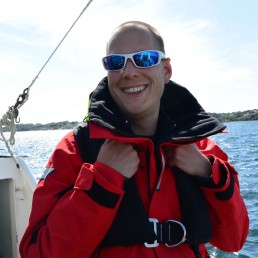Open Session
07. July 202111 am CEST
This session is for all of you who not fitted into a session jet but always wanted be a part of the ICYMARE online forum.
So if you want to share your latest research please send in your application as a speaker and we will make a nice round session out of the talks than.
We really look forward to here from you.
Abstract Submission Deadline is the 2nd July 2021
Jan
Speakers and Abstracts
Effects of Organic Matter Cycling on Rare Earth Element behaviour in seawater during a phytoplankton spring bloom
Mara Sutorius 1, Corinna Mori 1, Lea Boettcher 1, Carina Bunse 1, Leon Dlugosch 1, Janek Greskowiak 2, Nils Hintz 1, Katharina Pahnke 1
1 Institute for Chemistry and Biology of the Marine Environment (ICBM), Carl von Ossietzky University of Oldenburg, Oldenburg, Germany
2 Institute of Biology and Environmental Sciences, Carl von Ossietzky University of Oldenburg, Oldenburg, Germany
*corresponding author: ed.gr1744759859ubned1744759859lo-in1744759859u@sui1744759859rotus1744759859.aram1744759859
keywords: metal microbe interaction; organic metal complexation; mesocosm; biogeochemical modelling ; coastal North Sea
Rare Earth Elements (REE) show nutrient-like vertical profiles in the open ocean water column, even though there is no evidence for active uptake by organisms. Certain organisms can however interact with REE via sorption processes. Phytoplankton thereby shows higher affinities for light REE (LREE) over the heavy REE (HREE); bacterial surfaces show higher affinities for HREE over LREE. Additionally, in terrestrial systems organic matter (OM) was found to control REE speciation with increasing relevance for HREE. In the marine environment, the influence of OM on the overall REE distribution is mostly considered insignificant and thus is largely overlooked. With respect to the mentioned research findings, this assumption is highly questionable. Aim of this study therefore is to evaluate the effect of OM cycling on REE concentration patterns in the marine water column. We analysed the distribution of dissolved REE during an artificially induced, mesocosm based, phytoplankton spring bloom. Measurement in high temporal resolution in one enclosed seawater mass enabled the investigation of REE in close association to the OM cycling. We observed temporal patterns in dissolved REE concentrations that we can link to variations in the OM pool. Two bio-associated shuttles possibly transfer REE between the particulate and the dissolved phase. The phytoplankton-shuttle is characterized by adsorption on the particulate OM; the heterotrophic-shuttle is characterized by desorption processes through heterotrophic activity. The strength of these shuttles decreases with atomic number. Simulations of organic complexation of REE, modelled via PHREEQC, revealed high relevance of organic ligands for HREE and only small effects on LREE. Organic complexes act as buffers against adsorption being opponent to the phytoplankton-shuttle. Our findings show that biological productivity and associated OM cycling impacts REE distributions in seawater. An aspect that should be considered when interpreting past and present REE distributions
The conservation status of seagrasses in Portugal: an optimist view
Duarte Frade 1, Ester A. Serrão 1
1 CCMAR- Centre for Marine Sciences, University of the Algarve, Faro, Portugal
Corresponding author: moc.l1744759859iamg@1744759859edarf1744759859gd1744759859
Keywords: seagrass; conservation
Seagrasses are keystone species in coastal environments, proving habitat, nurseries, and food for a range of organisms, as well as a range of ecosystem services. The Portuguese coast is a key biogeographic transition, harbouring a mix of Mediterranean and cold-temperate seagrasses (Cymodocea nodosa, Zostera marina, Z. noltei, Ruppia spiralis, R. maritima, and R. drepanensis). Many of these species have their northern or southernmost range edges in Portugal, resulting in genetically unique but vulnerable populations. In 2018, we have assessed the conservation status of the Portuguese seagrasses using IUCN criteria, as part of the National Red List of Vascular Plants. Past records were obtained from the literature, previous studies, and historical herbaria and collections. All species were found to have undergone population declines and local extinctions: C. nodosa, Z. marina and R. spiralis were assessed as Vulnerable, R. maritima and Z. noltei as Near Threatened, and R. drepanensis as Critically Endangered, Possibly Regionally Extinct. Since 2018, further studies and recent fieldwork revealed several population recoveries, aided by ongoing restoration work, and R. drepanensis was rediscovered in May 2021. Nonetheless, large-scale dredging efforts are an ongoing threat, despite growing awareness and public campaigning.
Robotic Infrared Vision: Enabling operation in fog and low-light environments
Leonard Günzel 1
1 University of applied science Bremerhaven, Germany
Corresponding author: moc.l1744759859iamg@1744759859lezne1744759859ugoel1744759859
Keywords: thermal imaging; remote robotic application; Sensorik perception; thermal vision in fog; search and rescue
Robots advance further in the scientific and industrial work field and support or even replace humans in dangerous environments. Still these high-end machines tend to struggle with unexpected obstacles and have not reached the degree of flexibility which would allow for full autonomous operation modes. To enhance flexibility robots need a larger and broader set of sensors and a better implementation of these in the decision-making process.
The scenario discussed in this paper is the operation of robots in fog or smoke, circumstances which set an end to many autonomous operations and are still hard to manage even for humans. To increase the observational capacity the legged robot discussed in this thesis was equipped with a thermal camera which was integrated into the controlling unit to achieve maneuverability in environments which would not have been accessible before. To understand the significance of thermal imaging in low-light environments, fog or smoke, the physical background for the extinction of light in this environment will be discussed. The devices chosen for this setup (i.e. the robot and the thermal camera) will be discussed on the basis of the parameters of greatest importance of each. The computer which was needed as an interface between the both will be addressed in this context and especially the software developed for it.
The performance of the system will be discussed on the basis of a field test in fog. Proving, that the implemented system enhanced the situational awareness of the operator and allowed for operation under circumstances which would have not been possible without the thermal capacity.
The system proved to be capable of detecting a person in an environment with high fog density. It was further able to approach the person in an obstacle filled environment and therefore gather more detailed information about the scene.



